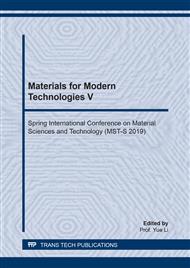[1]
Anvari S Z, Karimzadeh F, Enayati M H. Synthesis and characterisation of nanostructured Al-Al3V and Al-(Al3V-Al2O3) composites by powder metallurgy. Materials Science & Technology. 2017;1-12.
DOI: 10.1080/02670836.2017.1366736
Google Scholar
[2]
Dursun T, Soutis C. Recent developments in advanced aircraft aluminium alloys. Materials & Design. 2014;56: 862-871.
DOI: 10.1016/j.matdes.2013.12.002
Google Scholar
[3]
Shash A, Amer A E, El-Mahallawi I S, et al. The Effect of Process Parameters on the Mechanical Properties of A356 Al-Alloy/ZrO2 Nanocomposite. Journal of Nano Research. 2016;38(1661-9897):1-8.
DOI: 10.4028/www.scientific.net/jnanor.38.1
Google Scholar
[4]
Gangolu S, Rao A G, Sabirov I, et al. Development of Constitutive Relationship and Processing Map for Al-6.65Si-0.44Mg Alloy and Its Composite with B4C Particulates. Materials Science & Engineering A. 2016; 655: 256-264.
DOI: 10.1016/j.msea.2015.12.093
Google Scholar
[5]
Wang Z J, Si N C. Synthesis and Refinement Performance of the Novel Al-Ti-B-RE Master Alloy Grain Refiner. Rare Metal Materials and Engineering. 2015;44(12): 2970-2975.
DOI: 10.1016/s1875-5372(16)60032-2
Google Scholar
[6]
Ding W, Zhao W, Xia T. Grain refining action of Alâ 5Tiâ "C and Alâ "TiC master alloys with Alâ,5Ti master alloy addition for commercial purity aluminium. Cast Metals. 2014;27(3):187-192.
DOI: 10.1179/1743133614y.0000000106
Google Scholar
[7]
Sreekumar V M, Eskin D G. A New Al-Zr-Ti Master Alloy for Ultrasonic Grain Refinement of Wrought and Foundry Aluminum Alloys. JOM. 2016;68(12): 3088-3093.
DOI: 10.1007/s11837-016-2120-x
Google Scholar
[8]
Bunn A M, Schumacher P, Kearns M A, et al. Grain refinement by Alâ"Tiâ"B alloys in aluminium melts: a study of the mechanisms of poisoning by zirconium. Metal Science Journal. 1999;15(10):1115-1123.
DOI: 10.1179/026708399101505158
Google Scholar
[9]
Wang X, Han Q. Relationships of diboride phases in Al-Ti(Zr)-B alloys. Materials Science & Technology. 2014;31(7):874-879.
DOI: 10.1179/1743284714y.0000000670
Google Scholar
[10]
Banerji A, Reif W. Development of Al-Ti-C grain refiners containing TiC. Metallurgical and Materials Transactions A. 1986;17(12): 2127-2137.
DOI: 10.1007/bf02645911
Google Scholar
[11]
Wang E Z, Liu X F. Grain refinement limit of commercial pure Al inoculated by Al-Ti-C(B) master alloys. China Foundry. 2015;12(02):99-103.
Google Scholar
[12]
Tang P, Li W, Wang K, et al. Effect of Al-Ti-C master alloy addition on microstructures and mechanical properties of cast eutectic Al-Si-Fe-Cu alloy. Materials & Design. 2017;115: 147-157.
DOI: 10.1016/j.matdes.2016.11.036
Google Scholar
[13]
Wang T, Gao T, Zhang P Z, et al. Influence of a new kind of Al-Ti-C master alloy on the microstructure and mechanical properties of Al-5Cu alloy. Journal of Alloys and Compounds. 2014;589: 19-24.
DOI: 10.1016/j.jallcom.2013.11.187
Google Scholar
[14]
Tronche A, Vandyoussefi M, Greer A L. Instability of TiC particles in aluminium melts inoculated with an Al-Ti-C grain refiner. Metal Science Journal. 2002;18(10):1072-1078.
DOI: 10.1179/026708302225006034
Google Scholar
[15]
Xue Z, Li Y X. Effect of powder particle size on laser induced self‐propagating high temperature synthesis reaction in Al-Ti-C system. Powder Metallurgy. 2013;54(2):113-117.
DOI: 10.1179/174329009x409642
Google Scholar
[16]
Jiao X Y, Wang X H, Kang X Q, et al. Effect of heating rate on porous TiAl-based intermetallics synthesized by thermal explosion. Materials and Manufacturing Processes. 2017;32(5): 489-494.
DOI: 10.1080/10426914.2016.1232826
Google Scholar
[17]
Rasooli A, Boutorabi M A, Divandari M, et al. Effect of high heating rate on thermal decomposition behaviour of titanium hydride (TiH2) powder in air. Bulletin of Materials Science. 2013;36(2):301-309.
DOI: 10.1007/s12034-013-0455-2
Google Scholar
[18]
Zhang B Q, Fang H S, Ma H T, et al. Aluminothermal reaction to prepare Al-Ti-C master alloy. Transactions of Nonferrous Metals Society of China-English Edition. 2000;10(1):1-5.
Google Scholar
[19]
Zhao H L, Song Y, Li M, et al. Grain refining efficiency and microstructure of Al-Ti-C-RE master alloy. Journal of Alloys and Compounds. 2010;508(1): 206-211.
DOI: 10.1016/j.jallcom.2010.08.047
Google Scholar
[20]
Wang J W. The Review on Research Method of Alumina Dissolution in Cryolite Melting. Guangzhou Chemical Industry. 2011;39(10):19-22.
Google Scholar


